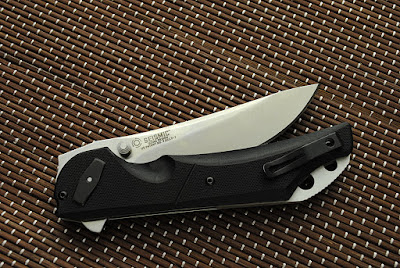Sherman, set the Wayback Machine
to the mid-60s.
Buck Knife has knocked America
and the world on its collective ass with the Buck 110 Hunter. It’s not the first lock-back knife, but the
combination of a solid lock, 420HC stainless with great heat treatment and a
belt carry pouch occurs at the right point in time. Everyone carries one. My favorite literature hero, Matt Helm
carries one; I sold a very nice German locking knife to my brother so I could buy
one.
Cops, firemen, soldiers, outdoors
men, scout masters all wanted to carry a Buck 110 Hunter.
 |
| Case's Shark Tooth |
This doesn’t pass unnoticed by
Case Knife. Coming out of WWII Case
remains a conservative company making knives the old fashioned way by hand with
carbon steel blades. Case wants in on this
market share. They just don’t want to compete;
they want to send Buck home hungry. By
1972 they have their world beater. They
call it the Shark Tooth.
The Shark Tooth is a spine locking blade with a
palm swell to fit your hand better than the slab-sided Buck. The 3-inch blade is backed with a finger
divot so you can choke-up for fine work and still get the long blade
reach. The blade is stainless steel that
holds an edge, but its identity isn’t revealed.
I don’t know why. Both bolsters
are brass, but the back one is cut on an angle to give it a streamline
appearance. This knife also comes with a
leather pouch cause weighs almost a half-pound!
Too heavy or bulky to flop in a pocket.
The wood insert with the palm
swell will be made from curly maple, but problems stops production. The 1974 catalog (printed in 1973, I assume)
has a picture of the Shark Tooth, but it’s stamped “Unavailable.”
 |
| The back edge beveled for a more streamline appearance |
Finally Case decides on replacing
the maple with Pakkwood and on December of 1975 finally ships the knives to distributors just in time for Christmas.
That made Santa very happy.
The Shark Tooth
stays in production until March 2009.
It’s a milestone
knife for Case. It marks the first use
of a blade made from a modern stainless steel with good tempered used in a Case
lock back. Several other types of Case
knives are released with that steel, but those are stories for another time.
Despite the
trouble Case had with the curly maple handle insert, it manages to make 1800 of
these. These are hidden in a vault
guarded by the Case gnomes. What a
treasure that would be to Case collectors.
It would be a unique collector’s knife, wouldn’t it? If only we could get past the gnomes.
Too late. In 1977 Case released all 1800 curly maple
handled Shark Tooth (Teeth?) to their distributors. Fox Mulder is right! They are out there!

